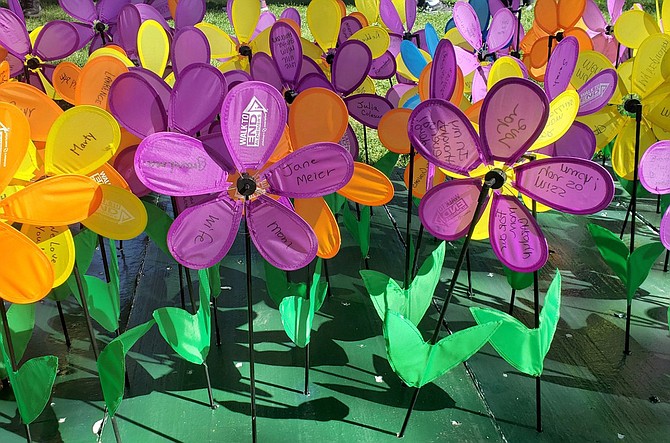Every morning when I walk out my front door to work, I see a pinwheel spinning in one of my flower pots in the garden. Some mornings it is whizzing quickly, a purple blur of color with a backdrop of dark green tiger lily leaves. On still days, the five leaves stare back at me as I walk by, handwritten words in black Sharpie marker: Jane, Mom, Wife, Grandma.
This flower has weathered the last two years without fading. It makes me happy to see it in the garden, spinning among the real flowers there. I imagine my mom admiring the work I’ve done creating a path of stepping stones through the middle of the grass I still need to kill off; the hanging baskets filled with purple and white petunias, colorful snapdragons, and peony plant trying its best to survive.
The purple flower with her name on it is from the 2019 Walk to End Alzheimer’s. We’ve been collecting these flowers since 2013, a bouquet of yellow and purple flowers representing my mom’s battle with the disease and her death a few years later because of it. While we participated in 2020, it was a virtual walk, and I’m happy we’ll be doing it in person on Oct. 2 at Yavapai College.
Everyone who signs up to walk receives one of these flowers. Yellow means you are caring for someone with Alzheimer’s or dementia, orange means you support the organization, blue if you have Alzheimer’s, and purple if you have lost someone to the disease.
There are tables with markers to let you decorate your flower with a name or message on the petals and then place it in the Memory Garden, to swirl in the early morning breeze. It is beautiful and terrible to see this garden grow with each participant that shows up. Each flower is a local family that is losing or has lost someone to Alzheimer’s disease.
During our first two years in Prescott, my dad and I carried yellow flowers, the petals blowing and spinning as we hiked up and down the hills around the courthouse square. In 2015, we picked up our first purple flower. It was tough to write “Mom” on my flower and know she was gone. I planted it in the Memory Garden next to a coworker’s flower who had recently lost her husband to the disease. I took a photo of them next to each other to share with her. That photo sits on my desk at home.
Maybe you’ve experienced Alzheimer’s (or other dementias) within your own family and watched as it slowly robbed your loved one of the ability to remember who they are, who you are, how to speak, and how to eat. Maybe you’ve had a friend, a coworker, a church member, or a neighbor who has gone on this horrible journey. Or perhaps you’ve been lucky and haven’t been touched by Alzheimer’s in your life, but understand and support the need for a cure. Whatever your experience, your presence at the Walk to End Alzheimer’s means the world to us. Whatever color your flower is, we want you there to be part of this big day. Go to http://act.alz.org and click on the link “Walk to End Alzheimer’s” to search by zip code and find your walk. Find a team you’d like to join or start your own. And if you see me on walk day, please stop me and say hello. I’ll be glad you did.
In 2017, the Alzheimer’s Association added a white flower to the Memory Garden to symbolize hope for the first survivor. Someday I hope there won’t need to be a memory garden at all, just a field of white flowers spinning with the names of the people we love who are still with us because there’s a cure. We’ll still walk to remember the loved ones we’ve lost but we’ll celebrate that no one else will need to go through what we’ve gone through.

